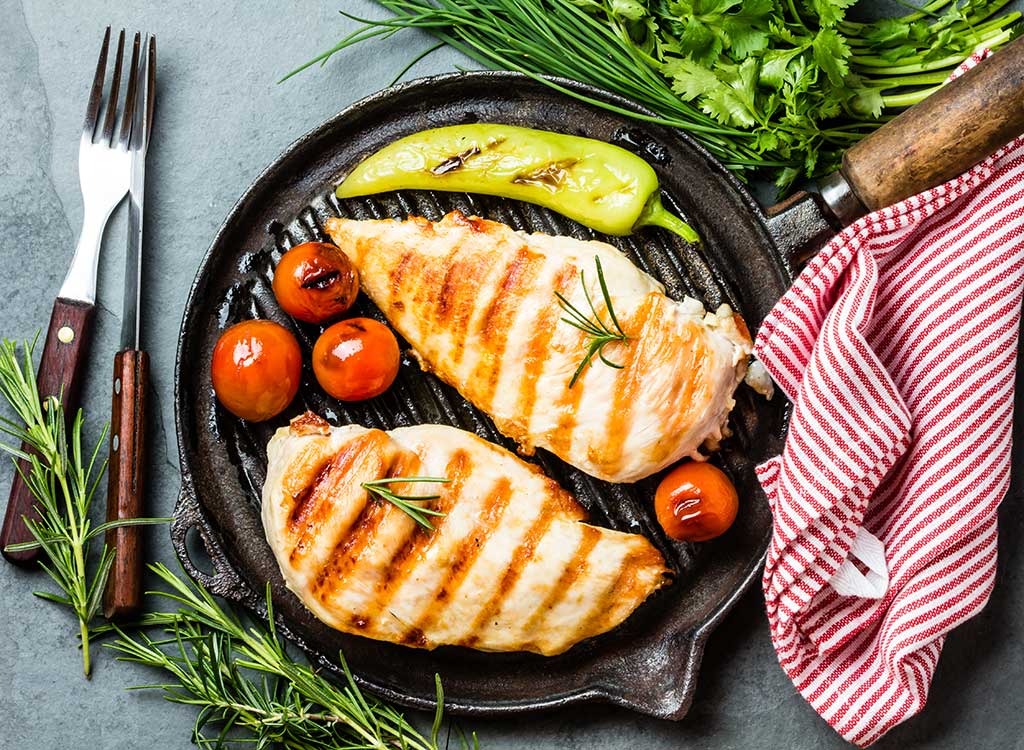
You've probably heard what feels like a million pieces of advice about what and how to eat. But one constant theme amongst experts is the recommendation to eat "lean protein." So what is lean protein, and what are some good sources of it?
What is lean protein?
Fortunately, there is an official definition. "According to the FDA, any seafood, meat, or poultry can be labeled as lean protein when it contains less than 10 grams of total fat, 4.5 grams or less of saturated fat, and less than 95 milligrams of cholesterol per 100 grams and per labeled serving size," says Mascha Davis MPH, RDN, a private practice registered dietitian nutritionist, founder of NomadistaNutrition.com and author of the upcoming book Eat Your Vitamins.
There's also a step above "lean protein," too. Davis points out that meat can be considered "extra lean" when it contains fewer than five grams of total fat, less than two grams of saturated fat, and less than 95 milligrams of cholesterol per 100 grams or serving size.
Why should you eat lean protein?
Doctors and nutritionists often recommend lean protein because it helps limit your saturated fat intake. As the American Heart Association explains, saturated fats raise levels of "bad" LDL cholesterol, a risk factor for heart disease.
"Protein is important, and most of us get enough of it," Davis says. "However, people often choose proteins that are high in saturated fats and cholesterol, which is why many dietitians urge consumers to make leaner choices and to try adding in plant-based options. Too much dietary fat from animal sources has a negative impact on health."
What are good sources of lean protein?
Here are some examples of what fits into this lean protein category, per the FDA:
- Beef: Not all cuts of beef will fit the lean meat parameters, but look for top round steak or roast, or tenderloin.
- Ground beef: The USDA recommends looking for ground beef that's 92 percent lean and 8 percent fat, Davis says. However, if you want it even leaner, you can find varieties that are 95 or 96 percent lean.
- Pork: Opt for a top loin chop, roast, or tenderloin.
- Deli meat: Pile your sandwich high with sliced ham or turkey. Roast beef is another stellar choice.
- Poultry: White meat is leaner than dark, and skinless saves on saturated fat. Go for skinless chicken or turkey breast.
Additionally, Davis recommends a few more lean protein picks to round out your choices:
- Eggs: One large egg white contains 17 calories, less than one of fat, and 3.6 grams of protein. Whole eggs meet the definition of lean protein in total and saturated fats, but they have more cholesterol.
- Tofu: The lean protein discussion shouldn't just focus on meat, says Davis. Soy products, like tofu, are a great source of lean protein. They contain cancer-fighting compounds called isoflavones, too. One 3.5-ounce serving of tofu has 10 grams of fat, but less than 1.5 grams of saturated fat.
- Seafood: It's hard to find a leaner source of protein than shrimp, which has less than half of a gram of fat per three-ounce serving. Combined with shrimp's high protein content, this makes for a great choice. On the fish front, Davis recommends shopping for sustainable fish, if that's possible and available to you. Lean protein choices include fish like tilapia, ocean perch, cod, flounder, haddock, mahi-mahi, and tuna, according to Seafood Health Facts.
- Legumes: Beans and lentils fall into this category. While they don't have quite as much protein as meat, they stand out as nutritional stars because they're rich in fiber, a nutrient that is good for your digestion, heart, and weight management.
How much lean protein should I eat?
Just because it's lean doesn't mean you should pile your plate high with a monster pork chop or chicken breast. "A serving of protein should be about the size of your palm," says Davis. That'll get you about three to four ounces, though everyone's needs are different, she adds.
If you're eating plant-based proteins like beans and lentils, you might consume a cup or a half cup, depending on the other foods in that meal. Either way, it's smart to swap out animal proteins for plant proteins, even if you usually eat lean meat.
"Reducing animal sources is not only great for your health, but also for the environment. Meat, especially beef, has a large environmental impact," says Davis. Aim to get a variety of lean proteins into your diet to mix things up—your body, heart, and taste buds will be pleased. Cheers to dinner tonight!




